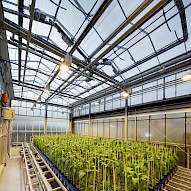Advanced Plant Phenotyping
Phenotypic data for growth and performance studies in research, breeding, and plant treatments
Phenotypes are the outer appearance of organisms and comprise all visible and measurable features that can be assessed from outside without major interfering with the plant. Basically, this comprises counts, dimensions, colors, and other surface properties delivering structural phenotypic information. Moreover, phenotypes include physiological features, such as photosynthetic processes, water status, biochemical properties of the surface, or temperatures.
Phenotypic data are required in research, breeding, agricultural monitoring, in product developments of fertilizers, agrochemicals, or plant adjuvants, and many more applications. For data recording, high-resolution cameras, IR/NIR cameras, fluorescence imaging systems, laser scanners, or hyperspectral imaging systems are applied, and recorded image data are processed with advanced algorithms that extract phenotypic information out of the recordings.
click on image to enlarge
APPLICATION CASES
SOLUTIONS
We bought a LemnaTec LabScanalyzer (the predecessor of PhenoAIxpert) in July 2018. The instrument was delivered to us and installed remotely by a Lemnatec technician that instructed us about the use of the instrument. We were happy about the service: very good communication and excellent instrument set-up. The Lemnatec LabScanalyzer works nicely and is even more user-friendly than we expected. Almost no training of new users is needed. We hope to expand the uses of the instrument to obtain additional phenotyping options in the future, by interacting with LemnaTec.












 Digital tools are key in state-of-the-art phenotyping. Mendel’s visual scoring was ground-breaking, but in the 21st century computer-assisted sensing and machine learning is the way forward in solution-oriented phenotype measuring.
Digital tools are key in state-of-the-art phenotyping. Mendel’s visual scoring was ground-breaking, but in the 21st century computer-assisted sensing and machine learning is the way forward in solution-oriented phenotype measuring. LemnaTec multi-sensor systems measure parameters in 2D
LemnaTec multi-sensor systems measure parameters in 2D 
 LemnaTec provides phenotypic data that explain gene functions and that are key to detect QTLs. Our digital phenotyping systems give insight how plants cope with limitation of water and nutrients, how they respond to light or CO2 and how pests and pathogens take influence on plant development. We are phenotyping samples for toxicology, environmental monitoring, and plant management. For breeders and gene banks, seed germination is a central trait for seed viability, which we analyse with digital image processing.
LemnaTec provides phenotypic data that explain gene functions and that are key to detect QTLs. Our digital phenotyping systems give insight how plants cope with limitation of water and nutrients, how they respond to light or CO2 and how pests and pathogens take influence on plant development. We are phenotyping samples for toxicology, environmental monitoring, and plant management. For breeders and gene banks, seed germination is a central trait for seed viability, which we analyse with digital image processing.